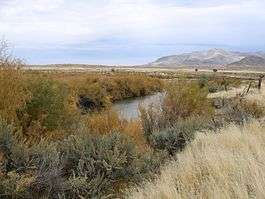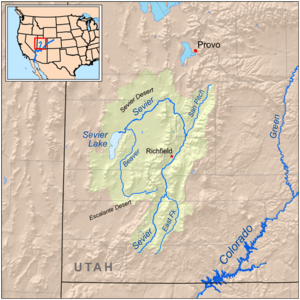Sevier River
| Sevier River (Seve'uu (Paiute)) | |
| "Rio Severo" (wild river) 1776: El Río de Santa Isabel c1826: Ashley River[1] | |
| river | |
 The Sevier River in Leamington, Utah | |
| Country | United States |
|---|---|
| State | Utah |
| Part of | Escalante-Sevier subregion |
| Tributaries | |
| - left | Beaver River |
| - right | East Fork, San Pitch |
| Length | 279 mi (449 km) [2] |
| Basin | 11,574 sq mi (29,977 km2) [3] |
| Discharge | for Gunnison, UT |
| - average | 257 cu ft/s (7 m3/s) [4] |
| - max | 5,400 cu ft/s (153 m3/s) |
| - min | 6 cu ft/s (0 m3/s) |
 The Sevier River upstream of the San Pitch confluence, along with the San Pitch, is to the east of the Great Basin section but within the Great Basin (west of the Great Basin Divide).
| |
The Sevier River /sɛˈvɪər/, extending 279 miles (449 km),[5] is the longest Utah river entirely in the state and drains an extended chain of mountain farming valleys to the intermittent Sevier Lake. The Upper Sevier is used extensively for irrigation, and consequently Sevier Lake is now essentially dry.
Course
The Sevier River Water Users Association subdivides the river into four mainstream sections: Upper, Central, Gunnison and Lower.[6]
Upper: The Sevier headwaters are in northwestern Kane County along the western side of the Paunsaugunt Plateau, and it flows northward into Garfield County through an extended valley beside the plateau past Hatch and Panguitch. Along the Garfield-Piute county line, the Sevier descends through the narrow 5 mi (8 km) Circleville Canyon, emerging into Circle Valley at Circleville. It then flows northeast towards Junction, where it receives the East Fork from the east and passes through the Piute Reservoir.
Central: It flows north across Piute County to Marysvale then descends through 8 mi (13 km) Sevier Canyon, emerging south of Sevier. It then flows northeast past Richfield and Salina.
Gunnison and Lower: After the San Pitch confluence and ~20 mi (32 km) southwest of Nephi, the river flows west around the north end of the Canyon Mountains into the Sevier Desert, then southwest past Delta and into Sevier Lake in central Millard County, along the western side of the Cricket Mountains. It is impounded in southeastern Juab County at the north end of the valley to form the 20-mi (32 km) long Sevier Bridge Reservoir. DMAD reservoir and Gunnison Bend reservoirs are near Delta with Sevier's water. DMAD water goes to the Intermountain Power Project's coal-fired plant located 9 miles west of US-6, north of Delta.
History
The Dominguez-Escalante Expedition crossed the river in 1776.
The Old Spanish Trail trade route followed the Sevier River from Salina Creek to the southwest to the point north of Panguitch where it left the river and crossed westward to what is now Parowan, Utah from 1829 into the 1850s.
The Sevier River Water Users Association has installed solar-powered monitoring equipment, the Real-time Telemetry System, which reports on river flows, canal diversion flows, reservoir elevations and weather each hour. See http://www.SevierRiver.org.
See also
References
- ↑ Van Cott, John Waldemar (1991) [1990]. Utah Place Names: A Comprehensive Guide to the Origins of Geographic Names. ISBN 0-87480-345-4.
- ↑ "The National Map". U.S. Geological Survey. Retrieved Feb 16, 2011.
- ↑ "Boundary Descriptions and Names of Regions, Subregions, Accounting Units and Cataloging Units". USGS.gov. Retrieved 2010-06-06.
- ↑ http://wdr.water.usgs.gov/wy2013/pdfs/10217000.2013.pdf
- ↑ Hopkins, Daniel J., editor (1997). Merriam-Webster's Geographical Dictionary. (Third Edition). Springfield, MA: Merriam-Webster, Inc. Publishers. p.1074. ISBN 0-87779-546-0
- ↑ "Sevier River Water Users Association". Retrieved 2010-06-06.
Coordinates: 39°02′57″N 113°07′53″W / 39.04917°N 113.13139°W